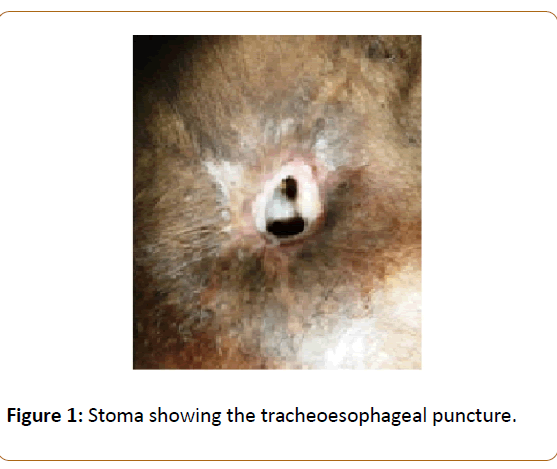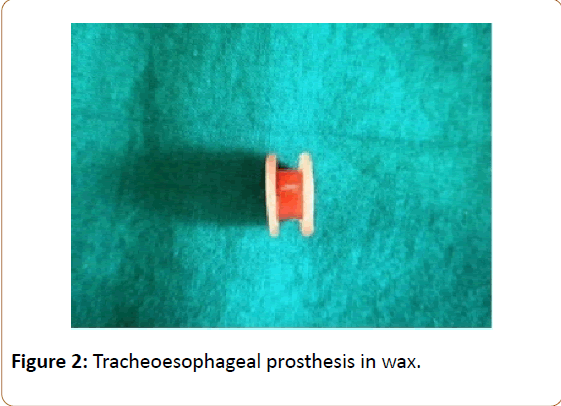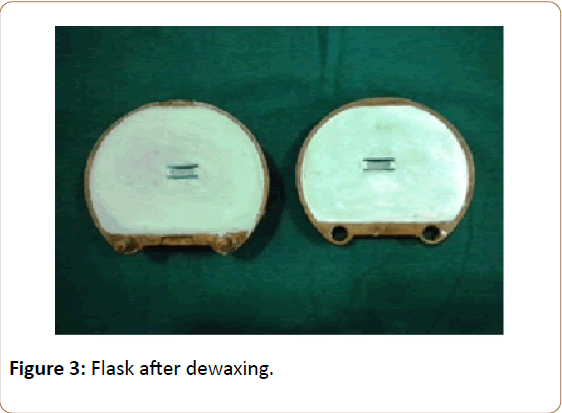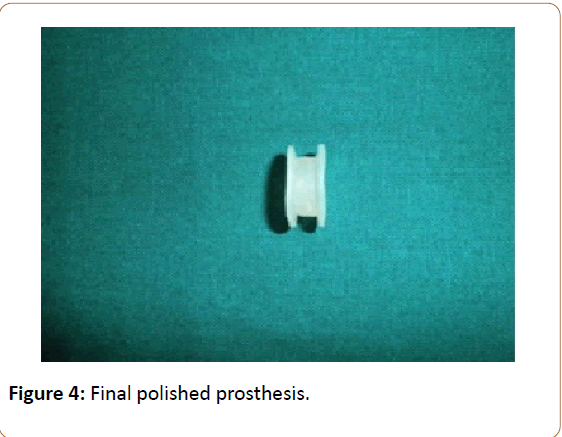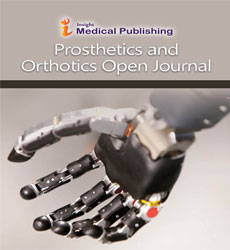Technique for Fabrication of Custom Tracheoesophageal Prosthesis to Reinstate Speech: Editorial Commentary
Pankaj Kharade*
Department of Prosthodontics, Dr. Ziauddin Ahmed Dental College and Hospital, Aligarh Muslim University, Aligarh, India
- *Corresponding Author:
- Kharade P
Department of Prosthodontics, Dr. Ziauddin Ahmed Dental College and Hospital
Aligarh Muslim University, Aligarh, India
Tel: +918859990440
E-mail: drpankaj_07@yahoo.co.in
Received date: May 12, 2017; Accepted date: August 8, 2017; Published date: August 12, 2017
Citation: Kharade P (2017) Technique for Fabrication of Custom Tracheoesophageal Prosthesis to Reinstate Speech: Editorial Commentary. Pros Orth Open J. Vol. 1 No. 2: 12.
Copyright: © 2017 Kharade P. This is an open-access article distributed under the terms of the Creative Commons Attribution License, which permits unrestricted use, distribution, and reproduction in any medium, provided the original author and source are credited.
Abstract
Tracheoesophageal prosthesis is an exceptional treatment modality for restoration of speech in patients with total laryngectomy. This prosthesis helps to direct the tracheal air exhaled into pharynx through fistulous area created due to Tracheoesophageal Puncture (TEP). The accomplishment of voice rehabilitation treatment depends on placement of a suitable prosthesis with accurate measurements. This article documents the method for fabrication of a custom made tracheoesophageal prosthesis with medical grade silicone using conventional Prosthodontic technique.
Keywords
Tracheoesophageal prosthesis; Total laryngectomy; Speech rehabilitation; Tracheoesophageal Puncture (TEP); Pharynx
Introduction
Tracheoesophageal Puncture (TEP) followed by restoration of speech with the help of TEP prosthesis had been described by Singer and Blom as an excellent choice of treatment for voice restoration after total laryngectomy [1]. In this procedure a small opening is made in the wall between the trachea and esophagus. The tracheoesophageal prosthesis is inserted through this opening. This prosthesis is having through and through opening from tracheal end to esophageal end. Air from lung can be directed through the pharynx with the help of this opening in the prosthesis by closing off the stoma during exhalation. This redirected air will help to create vibrations during its passage through a narrowed segment of the esophagus, making speech possible for most of the patients.
Tracheoesophageal puncture is categorized as primary TEP and secondary TEP. Primary TEP is performed at the time of laryngectomy whereas secondary TEP is performed after a gap of time. Secondary TEP shows relatively lesser chances of fistula formation as well as wound infection along with 100% acquisition of fluent speech [2]. The success of voice rehabilitation treatment depends on placement of a suitable prosthesis with precise measurements. Proper measurement of distance across puncture site will help predictable voice rehabilitation due to precision of fit of the prosthesis [3]. This article documents the procedure for fabrication of a custom made tracheoesophageal prosthesis with medical grade silicone using conventional Prosthodontic technique.
Technique
It represents a deeply recessed stoma along with the tracheoesophageal puncturesite (Figure 1).
• Fabricate two discs of same diameter with modeling wax after discussion with the surgeon as per instructions given by him. Fabricate a cylinder of the same wax with 4-5 mm lesser diameters. Join the discs with cylinder in such a manner that the cylinder will remain exactly in the center of the two discs (Figure 2). Get the dimensions approved by the surgeon.
• Invest the wax pattern of the tracheoesophageal prosthesis in the lower part or drag of the conventional denture flasks with the help of dental stone. Apply separating medium when dental stone in lower part of the flask will set.
• Fit upper part of the flask i.e., copes with the lower part of the flask. Pour dental stone in upper part of the flask and close the lid of the flask. Allow dental stone to set completely.
• After the stone has set, put the flasks in the dewaxing unit and carry out dewaxing in conventional manner (Figure 3). Paint a coat of paraffin xylene solution after removal of the clay and allow it to dry. Solution of paraffin and xylene will act as a separating medium for silicone.
• Cut the suitable quantity of High Temperature Vulcanizing (HTV) medical grade silicone material MDX 4-4515 which is available in slab form. Place small pieces of silicone in the hollowed out portion in the flask and close the flasks under the force of few thousand pounds [4]. Tighten the flasks to close them in proper manner.
• Cure the closed flask in hot air over at a temperature of 235°C for 1-5 hrs and at a temperature of 150°C for 4-5 hrs. After completion of curing, carry out cooling of the flasks under cold water.
• Open the flasks carefully and retrieve the prosthesis. Modify the diameter of hole in the prosthesis as per instructions of the surgeon so that the air directed to the pharynx will have minimum resistance. Modify the diameter in a tapering manner from one end to other end for safety purpose. Finish and polish the tracheoesophageal prosthesis. Polish the cylindrical portion of the prosthesis adequately for smooth insertion through the tracheoesophageal puncture (Figure 4).
• Sterilize the prosthesis by autoclaving or with ethylene oxide, followed by adequate ventilation.
Discussion
Appropriate length of the prosthesis is necessary for effective speech outcome and it can be achieved with the help of custom made tracheoesophageal prosthesis. The end of the prosthesis with smaller diameter is placed towards esophagus from safety point of view. The esophageal end can be kept closed during wax pattern fabrication as well as processing. Once the silicone has cured, a small cut can be made at the esophageal end. This cut will help the prosthetic device to work like one way valve due to elasticity of silicone. Flanges of the prosthesis in the form of discs create proper seal and prevent periprosthetic leakage. Flange of the prosthesis also prevents complete intrusion of the prosthesis into the esophagus. Nylon brushes with small diameter are used to clean the prosthesis on a regular basis. Patients are advised to have yogurt to restrict fungal growth. Certain carbonated drinks are also recommended to restrict fungal growth. In case of fungal infection Nystatin or Fluconazole can be prescribed depending upon clinical situation. Tracheoesophageal prosthesis being safe and simple procedure is more acceptable treatment alternative by patients compared to artificial larynx (electrolarynx) and esophageal speech. This technique makes the tracheo esophageal prosthesis more economical as compared to branded prosthesis.
Conclusion
The success of voice rehabilitation treatment depends on placement of a suitable prosthesis with precise measurements. This technique makes the tracheoesophageal economical as compared to branded one. This technique allows precise fabrication of tracheoesophageal prosthesis in accordance with appropriate dimensions leading to natural phrasing of voice and acoustically normal speech.
References
- Singer MI, Blom ED (1980) An endoscopic technique for the restoration of voice after laryngectomy. Ann Otol Rhino Laryngol 89: 529-533.
- Emerick KS, Tomycz L, Bradford CR, Lyden TH, Chepeha DB, et al. (2009) Primary versus secondary tracheoesophageal puncture in salvage total laryngectomy following chemoradiation. Otolaryngol Head Neck Surg 140: 386-390.
- Hotz MA, Baumann A, Schaller I, Zbären P (2002) Success and predictability of provox prosthesis voice rehabilitation. Arch Otolaryngol Head Neck Surg 128: 687-691.
- Bell WT, Chalian VA, Moore BK (1985 )Polydimethyl siloxane materials in maxillofacial prosthetics: evaluation and comparison of physical properties. J Prosthet Dent 54: 404-410.

Open Access Journals
- Aquaculture & Veterinary Science
- Chemistry & Chemical Sciences
- Clinical Sciences
- Engineering
- General Science
- Genetics & Molecular Biology
- Health Care & Nursing
- Immunology & Microbiology
- Materials Science
- Mathematics & Physics
- Medical Sciences
- Neurology & Psychiatry
- Oncology & Cancer Science
- Pharmaceutical Sciences
